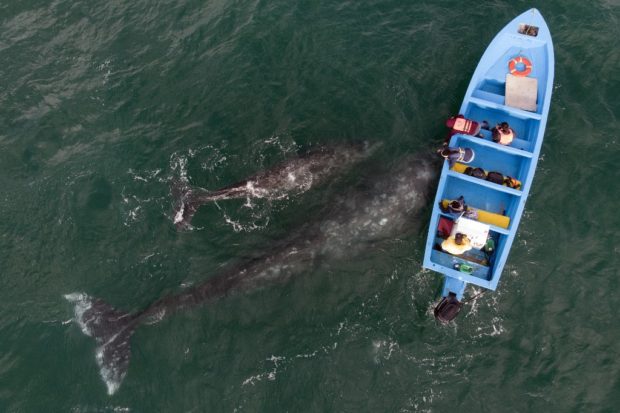Mexico tourists have whale of a time as pandemic eases

Aerial view of gray whales swimming near a whale watching boat at Ojo de Liebre Lagoon in Guerrero Negro, Baja California Sur state, Mexico on March 27, 2021. A reduction of contagions from COVID-19 has boosted whale watching tourism in Mexico. Each year hundreds of North Gray Whales travel thousands of miles from Alaska to the Baja California Peninsula breeding lagoons, part of El Vizcaino Gray Whale Sanctuary, a biosphere reserve and UNESCO World Heritage. Photo by Guillermo Arias / AFP
MULEGE, Mexico — A giant barnacle-encrusted gray whale nuzzles her calf next to a small boat of excited tourists in the waters off the Baja California peninsula in northwestern Mexico.
The annual arrival of the migratory mammals, coinciding with a drop in coronavirus infections, has provided a much needed boost to the region’s battered tourism industry.
For visitors, close encounters with one of the largest animals on the planet are a welcome respite from a pandemic that has killed more than 200,000 people in Mexico — the world’s third highest toll.
“It’s the best day of my life,” said Wilbert, a Mexican tourist who traveled from the southern state of Oaxaca to a coastal wildlife sanctuary in Baja California.
“I had dreamed of whales before so I was really keen to come.”
Article continues after this advertisementEach year, gray whales travel about 9,000 kilometers (5,500 miles) from their summer feeding grounds off Alaska to mate and give birth in the warmer waters off northwestern Mexico.
Article continues after this advertisementSimilar in size to a humpback whale but recognizable from their mottled grey coloring, they span up to around 15 meters (46 feet) and weigh as much as 30-40 tons.
‘Pay off some debt’
Mexico is one of the few major tourist destinations not to have closed its borders during the pandemic or demanded a negative Covid-19 test result from visitors on arrival.
As a result, it was the third-most visited country in the world in 2020.
But it has still been a disastrous time for the tourism industry and whale-watching tour operators were among those hit by a suspension of non-essential activities for part of last year.
Thanks to a decrease in coronavirus infections, the government allowed the boats to go out 30 percent full at the start of this January-April season, which was later increased to 50 percent.
“We kept the jobs and we hope to come out of it, if not with a profit, then at least being able to pay off some debt,” Luis Enrique Achoy, of whale watching company Malarrimo Eco-Tours, told AFP.
He said that it had been a good season with around 1,500 to 1,700 whales spotted in the El Vizcaino Biosphere Reserve.
‘Little by little’
Fisherman and tour guide Naman Dominguez was one of those affected by the pandemic restrictions.
“Right now, there’s a maximum of six or seven people per boat due to social distancing,” he said.
“But everything’s getting better little by little. As the level of infections has been low, tourism has been increasing.”
The gray whale’s survival was once at risk after commercial whalers found them wintering along the Baja California peninsula in the mid-19th century.
But the population in the eastern North Pacific has since rebounded strongly and the gray whale is today ranked “least concern” on the list of threatened species of the International Union for Conservation of Nature (IUCN).
The eastern North Pacific is home to the only definitely surviving breeding population, with an estimated size of up to around 27,000 gray whales, according to the IUCN.
And one of the best places to see them is in the lagoons off Baja California where they congregate in winter away from predators like killer whales, offering an unforgettable experience for visitors.
“We could touch them and see the mother with her calf. The two of them were playing for a good while with us,” said Mexican tourist Claudia Gaitan.
For more news about the novel coronavirus click here.
What you need to know about Coronavirus.
For more information on COVID-19, call the DOH Hotline: (02) 86517800 local 1149/1150.
The Inquirer Foundation supports our healthcare frontliners and is still accepting cash donations to be deposited at Banco de Oro (BDO) current account #007960018860 or donate through PayMaya using this link.